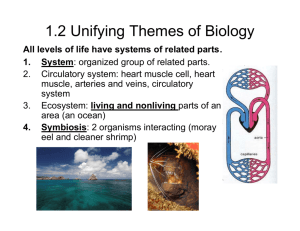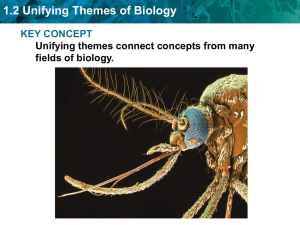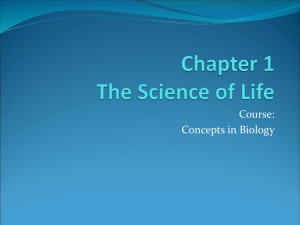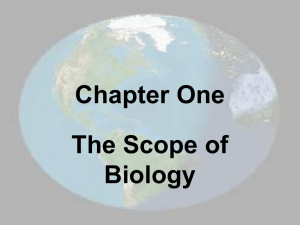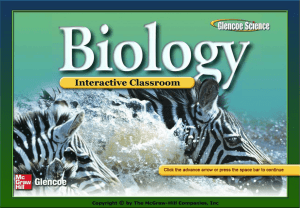File - Pearson`s Place
advertisement
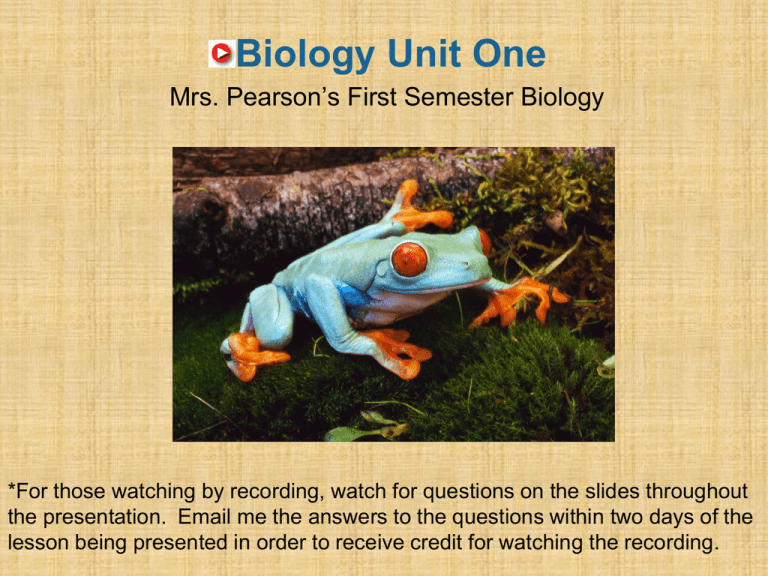
Biology Unit One Mrs. Pearson’s First Semester Biology *For those watching by recording, watch for questions on the slides throughout the presentation. Email me the answers to the questions within two days of the lesson being presented in order to receive credit for watching the recording. What did we do before we had technology? • When people found something they didn’t understand in nature, what did they do before the technology was developed to study it? For example, how did people explain volcanoes before we had the technology to study them? How about illness? • Do we still do that today? Context Clues • Technology has led to the rise of a new branch of science called genomics. Genomics can be used to study the genetic relationships among species. • Using the information above, how can you come to an educated guess about what “genomics” means? Unit One Objectives • Discuss the unifying themes of Biology • Hammer out the journal entry Unit One Break it down • What does it mean to “unify”? • Give an example of bringing things together under one idea. • What is a “theme”? • Give an example of a theme. Unit One Unifying Themes of Biology • Ideas that you see running through all of Biology and helping us to make connections about all living things and how they interact with each other and the environment. • Your text has too many and they really don’t show a unifying theme – they are more like details instead of overall concepts. • You’ll need to know them for your quizzes so let’s run over them quickly… Unit One Unifying Themes of Biology • Cellular Structure and Function – organisms are made of cells. • Reproduction – all living things reproduce • Metabolism – all living things require energy • Homeostasis – all living things must maintain a stable internal environment • Heredity – all living things pass traits on from one generation to the next • Evolution – all living things adapt to their environments over time • Interdependence – all living things are dependent upon one another and the environment Unit One Unifying Themes of Biology – THINK BIGGER! • Cellular Structure and Function – organisms are made of cells. – How would you look at this on a bigger scale? (Hint: Instead of looking just at cells…) • Reproduction – characteristic, not a theme • Metabolism – characteristic, not a theme although energy usage and how it cycles is important to understand • Homeostasis – finally one we can agree on! Look at it bigger though – because organisms must maintain stable internal environments… what does this affect? • Heredity – this is part of evolution and not its own theme • Evolution – again, look at it bigger – not just individuals or groups but entire systems interacting and affecting changes • Interdependence – whew, one more we can agree on and this one even looks at it from a nice big view! Unit One Unifying Themes of Biology – THINK BIGGER! • All living things have systems of related parts. • Structure is related to Function – how something is structured is related to the job it needs to do. • Homeostasis – maintaining balance is key to survival. • Evolution – changes in the environmental conditions and competition lead to regular changes over time • Interdependence – living things affect and are affected by each other and the environment in which they live. **Those watching by recording, include in your email the five themes of biology we will focus on as listed above. Unit One All levels of life have systems of related parts. • A system is an organized group of interacting parts. – A cell is a system of chemicals and processes. – A body system includes organs that interact. – An ecosystem includes living and nonliving things that interact. Unit One Can we build it?! • Start with the cell and build upward – what comes next? – Cell – Tissue – Organ – Organ system – Organism – Population – Community – Ecosystem Unit One Structure and function are related in biology. • Structure determines function. – Proteins with different structures perform different functions. – Heart muscle cells have a different structure and function than stomach muscle cells. – Different species have different anatomical structures with different functions. Unit One Organisms must maintain homeostasis to survive in diverse environments. Why? • Homeostasis is the maintenance of constant internal conditions. **Those watching by recording, include in your email the definition of homeostasis. Unit One What are some examples of conditions your body has to maintain in a constant fashion? What are some examples of conditions in your life you wish were maintained in a constant fashion? Unit One • Homeostasis is the maintenance of constant internal conditions. – Homeostasis is usually maintained through negative feedback. – Negative feedback systems return a condition to its normal (set) point. – Like your home’s thermostat… Unit One • Behaviors and adaptations can help maintain homeostasis. Unit One Evolution explains the unity and diversity of life. • Evolution is the change in living things over time. – The genetic makeup of a population of a species changes. – Evolution can occur through natural selection of adaptations. – Adaptations are beneficial inherited traits that are passed to future generations. Unit One • Evolution accounts for both the diversity and the unity of life. Unit One Interdependence • Living things affect and are affected by each other and the environment. – Ice - Temporary and permanent - Less of both and the temporary is lasting a shorter time Unit One Interdependence • Living things affect and are affected by each other and the environment. • Seals • Depend on the sea ice to reproduce and molt Unit One Interdependence • Living things affect and are affected by each other and the environment. • Polar bears • Gorge on naïve newborn and recently weaned seal pups, depositing a thick fat layer that allows them to survive long periods without food. • Depend on the annual sea ice for: • • • • A platform for hunting A habitat for mating Travel, migration, and connecting habitats Making a den and producing young Unit One Interdependence • Changing sea ice consequences for the polar bear: – Increased energy needs for movement – Altered home range size and configuration – Reduced access to den areas – Increased periods without access to prey – Altered prey species / food chains (walrus) – Increased time spent swimming (chills small cubs and reduces their survival) Unit One Interdependence • Evidence in western Hudson Bay subpopulation of polar bears: – Declines in body condition, reproduction and overall survival – 22% reduction in subpopulation size between 1987 and 2004 – More drowning bears – More thin bears – More problem bears • 20-25,000 bears left in the wild Unit One Assignments • Don’t panic!! They have several of them due at the end of the section but we’ll go over them in class so you won’t be buried in work. • Today we’ll get the journal entry out of the way – here are the instructions: – Here are six living things: a person, an oak tree, a mushroom, an amoeba, seaweed, and a bacterium. What features do they all have in common? How do they differ? Use the Internet to aid your research. – Please submit your journal entry to the Characteristics of Life assignment link. For information on how this assignment will be graded, please visit the Course Information section. Unit One Journal Entry – Step one!! What do they all have in common? What did you read about in the text that you can use to cover this? – Step two!! How are they different? – Step three!! Run grammar and spell check and make sure you are using complete sentences! Unit One Review • Unifying themes of Biology show the bigger ideas that unite living things into one study – Living things have systems of related parts – Structure is related to function – Homeostasis – Evolution – Interdependence • Journal Entries are due! Unit One Questions? • • Many of the slides in this presentation have been adapted from McDougal Littell’s 2008 version of Biology. Information on the polar bears is from the San Diego Zoo Institute for Conservation Research
